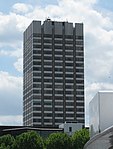Stamford Street

Stamford Street is a street in Lambeth and Southwark, London, England, just south of the River Thames. It runs between Waterloo Road to the west and Blackfriars Road to the east. It forms part of the A3200. The street has a wide variety of buildings. There are two large Georgian terraces, a school and the entrance to a chapel from the 1820s; a Victorian bank and hotel; an Edwardian hospital now used for student accommodation; early 20th century industrial buildings now forming the Waterloo campus of King's College London; office buildings from the 1930s and 70s; housing co-operatives from the 1980s and 90s; and a 21st-century residential tower with a second one under construction. At the western end, in the middle of a large roundabout, is the British Film Institute London IMAX Cinema.
Excerpt from the Wikipedia article Stamford Street (License: CC BY-SA 3.0, Authors, Images).Stamford Street
Stamford Street, London Lambeth (London Borough of Lambeth)
Geographical coordinates (GPS) Address Nearby Places Show on map
Geographical coordinates (GPS)
| Latitude | Longitude |
|---|---|
| N 51.5066 ° | E -0.1092 ° |
Address
Stamford Street 70
SE1 9NN London, Lambeth (London Borough of Lambeth)
England, United Kingdom
Open on Google Maps










